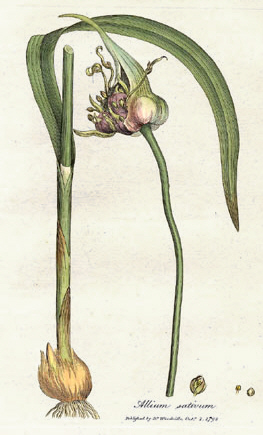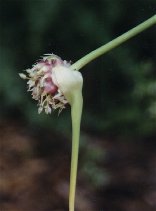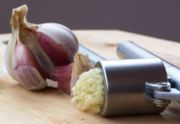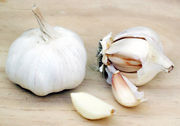| ?Garlic | ||||||||||||||||||
|---|---|---|---|---|---|---|---|---|---|---|---|---|---|---|---|---|---|---|

Garlic plants
|
||||||||||||||||||
| Scientific classification | ||||||||||||||||||
|
||||||||||||||||||
| Allium sativum |
| Garlic (edible
parts) Nutritional value per 100 g |
||||||||||
|---|---|---|---|---|---|---|---|---|---|---|
| Energy 150 kcal 620 kJ | ||||||||||
|
||||||||||
| Percentages are relative
to US
RDI values for adults. Source: USDA Nutrient database |
||||||||||
Garlic (Allium sativum) is a perennial plant in the family Alliaceae and genus Allium, closely related to the onion, shallot, and leek. It does not grow in the wild, and is thought to have arisen in cultivation, probably descended from the species Allium longicuspis, which grows wild in south-western Asia.[1] Garlic has been used throughout all of recorded history for both culinary and medicinal purposes.
The portion of the plant most often consumed is an underground storage structure called a head. A head of garlic is composed of a dozen or more discrete cloves, each of which is a botanical bulb, an underground structure comprised of thickened leaf bases. Each garlic clove may often be composed of just one leaf base, unlike onions, which almost always have multiple layers. The above-ground portions of the garlic plant are also sometimes consumed, particularly while immature and tender.
Garlic has a powerful pungent or "hot" flavor when raw, which mellows considerably when it is cooked. Raw or cooked, garlic is noted for its strong characteristic odor. [2]
Contents |
Biology and chemistry

Because of its wide cultivation, the origins of garlic are not fully certain. It is related to onions and lilies, and cultivated in the same manner as the shallot. The domesticated garlic plant does not produce seeds, but is grown from bulbs. These bulbs are the part of the plant most commonly eaten, though some cooks also use the early spring shoots. These shoots are often pickled in Russia and states of the Caucasus and eaten as an appetizer. A common error made by novice cooks is to misinterpret the word "clove" as meaning the entire garlic head (naturally occurring cluster of cloves, depending on the species) rather than one of its segments, thereby wildly exaggerating the amount of garlic in a recipe.
A garlic head is generally four to eight centimeters in diameter, white to pinkish or purple, and is composed of numerous (8 - 25) discrete bulbs. The foliage comprises a central stem 25 - 100 cm tall, with flat or keeled (but not tubular) leaves 30 - 60 cm long and 2 - 3 cm broad. The flowers are produced in a small cluster at the top of the stem, often together with several bulblets, and surrounded by a papery basal spathe; each flower is white, pink or purple, with six tepals 3 - 5 millimetres long. The flowers are commonly abortive and rarely produce any seeds.
The garlic plant has long, narrow, flat, obscurely keeled leaves. The head (compound bulb) has a flaky, mostly white outer layers of skin like that of an onion. Inside are 8-25 cloves, or smaller bulbs. From these, new bulbs can be procured by planting out in late winter or early spring.
The percentage composition of the bulbs is given by E. Solly (Trans. Hon. Soc. Loud., new ser., iii. p. 60) as water 84.09 %, organic matter 13.38 %, and inorganic matter 1.53 % - that of the leaves being water 87.14 %, organic matter 11.27 % and inorganic matter 1.59 %.

Like other members of the onion family, garlic actually creates the chemicals that give it its sharp flavor when the plant's cells are damaged. When a cell of a garlic clove is broken by chopping, chewing, or crushing, enzymes stored in cell vacuoles trigger the breakdown of several sulfur-containing compounds stored in the cell fluids. The resultant compounds are responsible for the sharp or hot taste and strong smell of garlic. Some of the compounds are unstable and continue to evolve over time. Among the members of the onion family, garlic has by far the highest concentrations of initial reaction products, making garlic much more potent than onions, shallots, or leeks.[3] Although people have come to enjoy the taste of garlic, these compounds are believed to have evolved as a defensive mechanism, deterring animals like birds, insects, and worms from eating the plant.[4]
A large number of sulfur compounds contribute to the smell and taste of garlic. Diallyl disulfide is believed to be an important odor component. Allicin has been found to be the compound most responsible for the spiciness of raw garlic. This chemical opens thermoTRP (transient receptor potential) channels that are responsible for the burning sense of heat in foods. The process of cooking garlic removes allicin, thus mellowing its spiciness.[5]
Uses


Culinary use
Garlic is most often used as a seasoning or a condiment. When crushed or finely chopped it yields allicin, a powerful antibiotic and anti-fungal compound (phytoncide). It also contains alliin, ajoene, enzymes, vitamin B, minerals, and flavonoids.
Garlic is widely used in many forms of cooking for its strong flavor, which is considered to enhance many other flavors. Depending on the form of cooking and the desired result, the flavor is either mellow or intense. It is often paired with onion, tomato, and/or ginger.
In culinary preparation, it is necessary to remove the parchment-like skin from individual cloves before chopping. Lightly crushing the cloves with the ball of the hand or flat of a knife makes this job much easier. Neither garlic nor herbs should be stored while covered in cooking oil as it is possible for botulism organisms to grow in the oxygen-free oil.
When eaten in quantity, garlic may be strongly evident in the diner's sweat and breath the following day. This is because garlic's strong smelling sulfur compounds are metabolized forming allyl methyl sulfide. Allyl methyl sulfide (AMS) cannot be digested and is passed into the blood. It is carried to the lungs and the skin where it is excreted. Since digestion takes several hours, and release of AMS several hours more, the effect of eating garlic may be present for a long time.
The well-known phenomenon of "garlic breath" is alleged to be alleviated by eating fresh parsley. This is, therefore, included in many garlic recipes, e.g. Pistou and Persillade. However, since garlic breath results mainly from digestive processes placing compounds such as AMS in the blood, and AMS is then released through the lungs over the course of many hours, eating parsley is at best a temporary fix. One way of accelerating the release of AMS from the body is the use of a sauna. Because of its strong odor, garlic is sometimes called the "stinking rose".
Hardneck garlic varieties feature a seedpod that grows atop a leafless stalk known as a "scape". Immature scapes are tender and edible. They are also known as "garlic spears", "stems", or "tops". Scapes generally have a milder taste than cloves. They are often used in stir frying or prepared like asparagus.
Medicinal use
| Components of garlic | |
| Phytochemicals | Nutrients |
|
Allicin Beta-carotene Beta-sitosterol Caffeic acid Chlorogenic acid Diallyl disulfide Ferulic acid Geraniol Kaempferol Linalool Oleanolic acid P-coumaric acid Phloroglucinol Phytic acid Quercetin Rutin S-Allyl cysteine Saponin Sinapic acid Stigmasterol Alliin |
Calcium Folate Iron Magnesium Manganese Phosphorus Potassium Selenium Zinc Vitamin B1 (Thiamine) Vitamin B2 (Riboflavin) Vitamin B3 (Niacin) Vitamin C |
| Source: Balch p 97[6] | |
Some scientific research indicates that garlic can have some health benefits, such as preventing and fighting common cold[7],diminishment of platelet aggregation[8]; a meta-analysis showing significant (8% compared to placebo) lowering of Low density lipoprotein carrying cholesterol (LDL-C) [9]; treatment of hyperlipidaemia[10]; the significant inhibition of atherosclerosis via the use of aged garlic extract Kyolic[11]; and the protective nature of chronic garlic intake on elastic properties of aorta in the elderly[12]. Regular and prolonged use of therapeutic amounts of aged garlic extracts lower blood homocysteine levels, and prevent some complications of diabetes mellitus. It may have some cancer-fighting properties because it is high in diallyl sulphide (DADs), believed to be an anticarcinogen.[13]
In modern naturopathy, garlic is used as a treatment for intestinal worms, both orally and as an anal suppository.
Garlic cloves continue to be used by aficionados as a remedy for infections (especially chest problems), digestive disorders, and fungal infections such as thrush. They are claimed to be an effective long-term remedy for cardiovascular problems reducing excessive blood cholesterol levels, atherosclerosis, the risk of thrombosis, and hypertension but these claims are disputed, as there has been no clinical trial that has demonstrated any such benefits. Whole cloves used as vaginal suppositories are sometimes used as a home remedy for Candidiasis (yeast infections). Garlic is also alleged to help regulate blood sugar levels, and so can be helpful in late-onset diabetes, though people taking insulin should not consume medicinal amounts of garlic without consulting a physician. In such applications, garlic must be fresh and uncooked, or the allicin will be lost.
Dietary supplements in pill form, as are commonly available, claim to possess the medicinal benefits of garlic, without (in the words of one manufacturer) "the unsocial qualities associated with fresh garlic cloves".
History
From the earliest times garlic has been used as an article of diet. It is very widely used in Lebanese cuisine. Many Lebanese salads contain a garlic sauce. It formed part of the food of the Israelites in Egypt (Numb. xi. 5) and of the labourers employed by Khufu in constructing the pyramid. Garlic is still grown in Egypt, but the Syrian variety is the kind most esteemed now (see Rawlinson's Herodotus, 2.125).
It was consumed by the ancient Greek and Roman soldiers, sailors and rural classes (cf. Virg. Ed. ii. II), and, as Pliny tells us (N.H. xix. 32), by the African peasantry. Galen eulogizes it as the "rustic's theriac" (cure-all) (see F Adams's Paulus Aegineta, p. 99), and Alexander Neckam, a writer of the 12th century (see Wright's edition of his works, p. 473, 1863), recommends it as a palliative of the heat of the sun in field labor.
Pliny the Elder, in his Natural History, (N.H. xx. 23) gives an exceedingly long list of scenarios in which it was considered beneficial. Dr. T. Sydenham valued it as an application in confluent smallpox, and, says Cullen (Mat. Med. ii. p. 174, 1789), found some dropsies cured by it alone. Early in the 20th century, it was sometimes used in the treatment of pulmonary tuberculosis or phthisis.
Garlic was rare in traditional English cuisine (though it is said to have been grown in England before 1548), and has been a much more common ingredient in Mediterranean Europe. Garlic was placed by the ancient Greeks on the piles of stones at cross-roads, as a supper for Hecate (Theophrastus, Characters, The Superstitious Man); and according to Pliny, garlic and onions were invoked as deities by the Egyptians at the taking of oaths. The inhabitants of Pelusium in lower Egypt, who worshipped the onion, are said to have had an aversion to both onions and garlic as food.
To prevent the plant from running to leaf, Pliny (Nat. Hist. xix. 34) advised bending the stalk downward and covering with earth; seeding, he observes, may be prevented by twisting the stalk (by "seeding", he most likely means the development of small, less potent bulbs).
Superstition and mythology
Garlic has been seen as a force for both good and evil. A Christian myth says that after Satan left the Garden of Eden, garlic arose in his left footprint, and onion in the right.[14] Even in Europe, though, many cultures have turned to garlic as a protective force or white magic, perhaps because of its reputation as a powerful preventative medicine.[15] Central European folk beliefs considered garlic a powerful ward against devils, werewolves, and vampires.[15] To ward off vampires, garlic could be worn on one's person, hung in windows, or rubbed on chimneys and keyholes.[16]
Classification
Classification of culinary garlic can be complex, with numerous cultivars being grown. The broadest division is into "hardneck" and "softneck" types; very broadly speaking, hardnecks have more intense flavours (which are more closely related to their wild ancestor) but lesser storage capabilities, while conversely softnecks are excellent "keepers" but often milder (those are broad-brush simplifications with numerous exceptions and half-exceptions). Within those two types, there are usually felt to be three subdivisions of hardnecks and two of softnecks.
The "wild garlic", "crow garlic" and "field garlic" of Britain are the species Allium ursinum, A. vineale and A. oleraceum, respectively. In North America, "wild garlic" or "crow garlic" is Allium vineale, and along with "wild onion" (also known as "meadow garlic" or "wild garlic") Allium canadensis, are common weeds in fields. Elephant garlic is a variant of the leek species, A. ampeloprasum, and is larger and milder than true garlic.[17]
Preservation

The types differ not only in culinary qualities, but in storage potential. Under good storage conditions, which are not hard to achieve (room temperature and medium to low humidity), one can hope for these results:
- Asiatic, Turban and Porcelain types: a few months
- Rocambole and Purple Stripe types: 6 to 8 months
- Artichoke types: 8 to 10 months
- Silverskin (including Creole) types: up to a full year
Rocamboles, however, have a tendency to dehydrate in storage under dry conditions (less than about 50% humidity).
The bulbs are best preserved hung in a dry place. If of fair size, four to six of them weigh about 500 g (1 lb). Also, it is very important to keep them out of the sun. A dark corner of the room is best.
Do not store garlic in oil at room temperature. See Caution, below.
Caution
- Cases of botulism have been caused by consuming garlic-in-oil preparations. It is important to add acid when creating these mixtures and to keep them refrigerated to retard bacterial growth. [18]
- While culinary quantities are generally safe, during pregnancy and lactation garlic can cause digestive problems such as heartburn, and babies may dislike the taste in breast milk.
- The medicinal effects of taking garlic long-term are largely unknown, and no FDA approved study has been performed.
Trivia
- South Korea is the largest consumer of garlic.
- In the United States, Gilroy, California promotes itself as "Garlic Capital of the World", and hosts the Gilroy Garlic Festival every summer.
- In 2005, a poll of 2,000 people revealed garlic to be Britain's 6th favourite culinary vegetable. [1]
- In the televised cartoon shorts, before he used spinach as a source of superhuman strength, comic book character Popeye's ancestor Hercules would sniff fresh bulbs of unpeeled garlic.
- Garlic is Wario's favorite food. When he eats it in WarioWare: Touched!, he becomes Wario-Man.
References
- McGee, Harold (2004). On Food and Cooking (Revised Edition). Scribner. ISBN 0-684-80001-2. pp 310–313: The Onion Family: Onions, Garlic, Leeks.
- Salunkhe, D.K.; Kadam, S.S. (1998). Handbook of Vegetable Science and Technology. Marcel Dekker. ISBN 0-8247-0105-4.
- Koch, H. P.; Lawson, L. D. (1996). Garlic. The Science and Therapeutic Application of Allium sativum L. and Related Species (Second Edition). Williams & Wilkens. ISBN 0-683-18147-5.
- James Mellgren (2003).
- Hamilton, Andy (2004). Selfsufficientish - Garlic. Retrieved 1 May 2005.
- R. Kamenetsky, I. L. Shafir, H. Zemah, A. Barzilay, and H. D. Rabinowitch (2004). Environmental Control of Garlic Growth and Florogenesis. J. Am. Soc. Hort. Sci. 129: 144-151.
- Lindsey J. Macpherson, Bernhard H. Geierstanger, Veena Viswanath, Michael Bandell, Samer R. Eid, SunWook Hwang, and Ardem Patapoutian (2005). "The pungency of garlic: Activation of TRPA1 and TRPV1 in response to allicin". Current Biology 15 (May 24): 929-934.
- Balch, P. A. (2000). Prescription for Nutritional Healing, 3rd ed. New York: Avery.
- Block, E. (1985). The chemistry of garlic and onions. Scientific American 252 (March): 114-119.
- Block, E. (1992). The organosulfur chemistry of the genus Allium -- implications for organic sulfur chemistry. Angewandte Chemie International Edition 104: 1158-1203.
- Breithaupt-Grogler, K., et al. (1997). Protective effect of chronic garlic intake on elastic properties of aorta in the elderly. Circulation 96: 2649-2655. Abstract.
- Efendy, J. L., et al. (1997). The effect of the aged garlic extract, 'Kyolic', on the development of experimental atherosclerosis. Arterosclerosis 132: 37-42. Abstract.
- Hile, A. G.; Shan, Z.; Zhang, S.-Z.; Block, E. (2004). Aversion of European starlings (Sturnus vulgaris) to garlic oil treated granules: garlic oil as an avian repellent. Garlic oil analysis by nuclear magnetic resonance spectroscopy. Journal of Agricultural and Food Chemistry 52: 2192-2196. [2]
- Jain, A. K. (1993). Can garlic reduce levels of serum lipids? A controlled clinical study. American Journal of Medicine 94: 632-635. Abstract.
- Lawson, L. D.; Wang, Z. J. (2001). Low allicin release from garlic supplements: a major problem due to sensitivities of alliinase activity.Journal of Agricultural and Food Chemistry 49: 2592-2599. [3]
- Mader, F. H. (1990). Treatment of hyperlipidemia with garlic-powder tablets. Arzneimittel-Forschung/Drug Research 40 (2): 3-8. Abstract.
- Silagy, C., and Neil, A. (1994). Garlic as a lipid-lowering agent - a meta-analysis. Journal of the Royal College of Physicians 28 (1): 2-8. Abstract
- Steiner, M., and Lin, R.S. (1998). Changes in platelet function and susceptibility of lipoproteins to oxidation associated with administration of aged garlic extract. Journal of Cardiovascular Pharmacology 31: 904-908. Abstract
- Yeh, Y-Y., et al. (1999). Garlic extract reduces plasma concentration of homocysteine in rats rendered folic acid deficient. FASEB Journal 13(4): Abstract 209.12.
- Yeh, Y-Y., et al. (1997). Garlic reduced plasma cholesterol in hypercholesterolemic men maintaining habitual diets. In: Ohigashi, H., et al. (eds). Food Factors for Cancer Prevention. Tokyo: Springer-Verlag. Abstract. This is a meta-reference and includes 205 scientific and non-scientific papers from the United States National Library of Medicine [4].
Notes
- ^ Saulnkhe and Kadam p. 397
- ^ Gernot Katzer's Spice Pages.
- ^ McGee p. 310-311
- ^ Macpherson et al. section "Conclusion"
- ^ Macpherson et al.
- ^ Balch, Phyllis A. (2000). Prescription for Nutritional Healing, 3rd ed. New York: Avery. p. 97.
- ^ http://news.bbc.co.uk/2/hi/health/1575505.stm
- ^ http://www.ncbi.nlm.nih.gov/entrez/query.fcgi?cmd=Retrieve&db=PubMed&list_uids=9641475&dopt=Citation
- ^ [http://www.ncbi.nlm.nih.gov/entrez/query.fcgi?cmd=Retrieve&db=PubMed&list_uids=8506890&dopt=Citation Can garlic reduce levels of serum lipids? A controlled clinical study.] Am J Med. 1993 Jun;94(6):632-5. "Low-density lipoprotein cholesterol (LDL-C) was reduced by 11% by garlic treatment and 3% by placebo"
- ^ http://www.ncbi.nlm.nih.gov/entrez/query.fcgi?cmd=Retrieve&db=PubMed&list_uids=2291748&dopt=Abstract
- ^ http://www.ncbi.nlm.nih.gov/entrez/query.fcgi?cmd=Retrieve&db=PubMed&list_uids=9247357&dopt=Citation
- ^ http://www.ncbi.nlm.nih.gov/entrez/query.fcgi?cmd=Retrieve&db=PubMed&list_uids=9355906&dopt=Citation
- ^ Abstract
- ^ Pickering, David (2003). Cassell's Dictionary of Superstitions. Sterling Publishing. ISBN 0-304-36561-0. p. 211
- ^ a b McNally, Raymond T (1994). In Search of Dracula. Houghton Mifflin. ISBN 0-395-65783-0. p. 120.
- ^ McNalley p. 122; Pickering p. 211.
- ^ McGee p. 112
- ^ http://www.colostate.edu/Orgs/safefood/NEWSLTR/v2n4s08.html
Films
- 1980 - Garlic is as Good as Ten Mothers. Directed by Les Blank.
External links
- Garlic: An Herb Society of America Guide
- Garlic at Gernot Katzer's Spice Pages
- Garlic for the home gardener
- Plant Cultures: botany, history and uses of garlic
- Garlic: Plants For a Future database
- LoveGarlic.eu Garlic realted Recipes, Information and Wiki
- Herbal information
- HerbMed
- Health Benefits of Garlic
- Herbalist David Hoffmann @ Health World
- Memorial Sloan-Kettering Cancer Centre
- Longwood Herbal Task Force (pdf)
- Eclectic herbal information
- King's American Dispensatory @ Henriette's Herbal
- Mrs. Grieve's A Modern Herbal @ Botanical.com




 216.73.216.81
216.73.216.81 User Stats:
User Stats:
 Today: 0
Today: 0 Yesterday: 0
Yesterday: 0 This Month: 0
This Month: 0 This Year: 0
This Year: 0 Total Users: 117
Total Users: 117 New Members:
New Members:
 216.73.xxx.xx
216.73.xxx.xx
 Server Time:
Server Time: